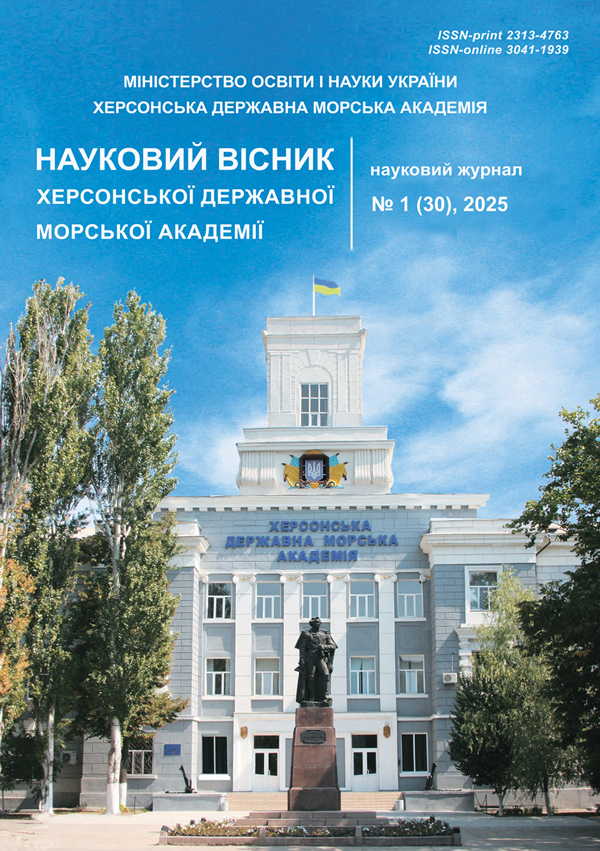FUNCTIONAL DIAGNOSTICS OF SHIPBOARD HIGH-VOLTAGE ELECTRICAL MACHINES
https://doi.org/10.33815/2313-4763.2025.1.30.102-116
Abstract
The article is devoted to the development of methods for the functional diagnostics of high-voltage electrical machines and their practical application in maritime transport. An analysis of the main approaches to the development of diagnostic techniques and tools for electrical machines demonstrates the feasibility of using integrated functional diagnostics. The set of diagnostic parameters must meet the requirements of completeness of description of all classes of defects, maximum sensitivity to changes in the values of structural parameters, minimum composition, accessibility for control and measurement, minimum cost and time of control and measurement, sufficient resolution in recognizing individual defects. The analysis of diagnostic parameters made it possible to form an effective set that includes parameters of vibration, temperature, current consumption and capacitance, and electro-discharge activity. The most effective application of these methods is the joint use of an integrated diagnostic system.
An algorithm for the complex functional diagnostics of shipboard high-voltage electrical machines has been developed. The structure for the system for diagnosing the technical condition is proposed, which allows to implement the developed diagnostic algorithm and is characterized by constructive simplicity and reliability. The complex diagnostics of high-voltage electrical machines can be formalized by means of models of classification of the technical condition and fault finding based on the results of classification. A fuzzy model for classifying the technical condition in the form of predicate rules has been developed, which allows determining the technical condition of an object based on the results of measuring the parameters of electrical discharge activity and the rms value of vibration velocity. Five classes of technical condition of the object are defined: “Normal”, “Normal with deviations”, “Normal with significant deviations”, ‘Deterioration’ or “Pre-emergency”. A fault detection model was developed and implemented using fuzzy logic.
The model makes it possible to detect faults in an object based on the measured values of current and vibration amplitudes at characteristic frequencies, as well as temperatures at control points. A method using a fuzzy model is proposed that searches for faults by the relative deviations of current and vibration amplitudes at characteristic frequencies, as well as temperatures at control points. The algorithm for assessing the technical condition allows to determine the current technical condition of the facility using a fuzzy logic apparatus based on the results of measuring the parameters of electrical discharge activity and the root mean square value of vibration velocity. In the case of a pre-emergency condition, a signal is generated to shut down the electrical machine. The algorithm for fault detection of shipboard high-voltage electrical machines is applied on a fuzzy logic model. The algorithm determines the causes of electrical machine failure based on the results of thermal imaging and spectral analysis of the supply current and vibration.
References
2. Ivanov, A. A., Tymofeiev, K. V., Avramenko, M. M., Rastohina, H. I. (2019). Trenazher vysokovoltnoho obladnannia dlia pidhotovky sudnovykh fakhivtsiv. Naukovyi visnyk Khersonskoi derzhavnoi morskoi akademii. 2019. № 1 (20). S. 20–29.
3. Electro-technical officer. (2014). Model course 7.08, International Maritime Organization, London. 181 p.
4. SOLAS (2020). Consolidated Edition. London: International Maritime Organization, 588 p.
5. Chornyi, O. P., Zachepa, Yu. V., Tytiuk, V. K., Chorna, O. A. (2019). Monitorynh i diahnostyka elektromekhanichnykh obiektiv : navchalnyi posibnyk. Kremenchuh. 122 s.
6. Ma, F., Qi, L., Ye, S., Chen, Y., Xiao, H., Li, S. (2023). Research on fault diagnosis algorithm of ship electric propulsion motor. Appl. Sci. 13, 4064.
7. Elektropryvod i avtomatyzatsiia (2015). Navchalnyi posibnyk / O. Iu. Syniavskyi, P. I. Savchenko, V. V. Savchenko, Yu. M. Lavrinenko, V. V. Kozyrskyi, Yu. M. Khandola, I. P. Ilichov, V. Iu. Ramsh, V. Ia. Bunko; Za red. O. Iu. Syniavskoho. 2-e vyd., dop i pererob., Kyiv. 604 s.
8. Gegenava, A., Khazanov, A. (2023). Statistical review of voltage endurance test of insulation for high voltage rotating machines stator windings with combined standard and accelerated tests. “Three Steps Test” TST. In Proceedings of the 2023 IEEE Electrical Insulation Conference (EIC), Quebec City, QC, Canada, pp. 1–4.
9. Jiang, B., Huang, X., Liu, Y., Nategh, S. (2021). Accelerated destructive experiment design of motor stator winding insulation systems. In Proceedings of the 2021 IEEE Workshop on Electrical Machines Design, Control and Diagnosis (WEMDCD), Modena, Italy, pp. 225–230.
10. IEC 60034-18-31-2012; Rotating Electrical Machines Part 18–31: Functional Evaluation of Insulation Systems Test Procedures for Form-Wound Windings Thermal Evaluation and Classification of Insulation Systems Used in Rotating Machines. International Electrotechnical Commission: Geneva, Switzerland, 2012; р. 15.
11. IEC 60034-18-32-2022; Rotating Electrical Machines Part 18–32: Functional Evaluation of Insulation Systems Test Procedures for Form-Wound Windings Evaluation by Electrical Endurance. International Electrotechnical Commission: Geneva, Switzerland, 2022; р. 15.
12. IEC 60034-18-33-2010; Rotating Electrical Machines Part 18–33: Functional Evaluation of Insulation Systems Test Procedures for Form-Wound Windings Multifactor Evaluation by Endurance Under Simultaneous Thermal and Electrical Stresses. International Electrotechnical Commission: Geneva, Switzerland, 2010; р. 11.
13. IEC 60034-18-34-2012; Rotating Electrical Machines Part 18–34: Functional Evaluation of Insulation Systems Test Procedures for Form-Wound Windings Evaluation of Thermomechanical Endurance of Insulation Systems. International Electrotechnical Commission: Geneva, Switzerland, 2012; р. 12.
14. Seri, P., Ghosh, R., Montanari, G.C. (2021). An unsupervised approach to partial discharge monitoring in rotating machines: Detection to diagnosis with reduced need of expert support. IEEE Trans. Energy Convers, 36, 2485–2492.
15. Xu, X., Yan, X., Yang, K., Zhao, J., Sheng, C., Yuan, C. (2021). Review of condition monitoring and fault diagnosis for marine power systems. Transp. Saf. Environ, 3, 85–102.
16. DSTU ISO 10816-1:2007. Vibratsiia. Kontrol stanu mashyn za naslidkamy vymiriuvan vibratsii na chastynakh, shcho ne obertaiutsia. Chastyna 1. Zahalni vymohy.
17. Han, J., Li, X. D., Yu, D.Y. et al. (2012). Application of rough set based fuzzy neural network in fault diagnosis. J Hefei Univ Technol Nat Sci. 35:577–80.
18. P. Balasubramaniam and N. Ramesh Babu. Fuzzy Logic Controllers and Applications. eBook (PDF) ISBN 978-0-85014-875-6. 2025 p. 126.
19. Sano, T. (2015). Diagnostic Frequency Response Analysis (FRA) Techniques for Faults in Transformers. MEIDEN REVIEW, vol. 7, no. 1, pp. 28–33.






